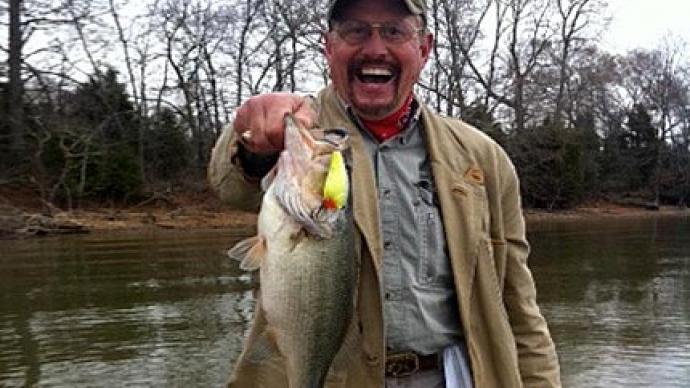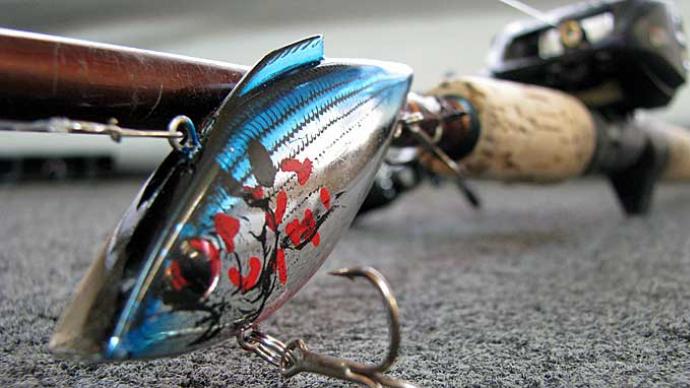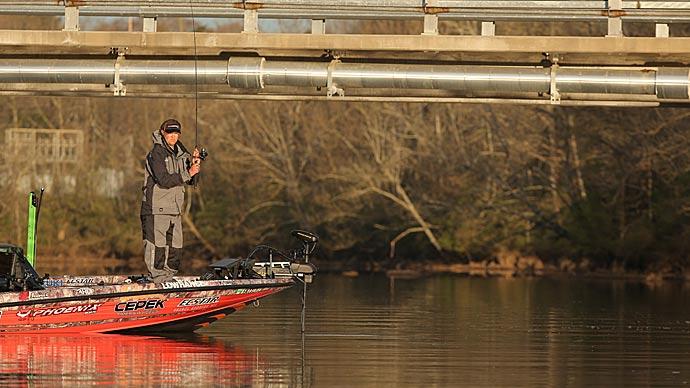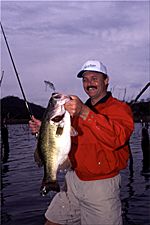
Any time an article comes out on tips to help you catch more and bigger bass, you can be assured that topics like structure, water temperature, fishing pressure, and weather conditions will be discussed. Based upon the above data, you can also be sure that the author will lend advice on lure selection. For example, he may suggest which type of lure, what color, and how to fish the bait.
All too often, a more straightforward, more logical approach to lure selection is your best bet. Examine the one thing that can lead you in the right direction - the natural bait the bass are feeding on.
Bass eat crawfish... they eat frogs, too. They'll even eat leeches and salamanders. But if you look inside the stomachs of 100 big bass, you'll find shad, bluegill, or baby crappie in 95 of them. It's no secret that big bass prey on small fish, mostly shad, minnows, or their look-alike. Therefore, logically, we should look first at lures that accurately imitate these baitfish.
Before we choose a lure, let's take one more logical step. Let's study the live prey a bit closer. All of the baitfish mentioned above have a few very similar characteristics. They are all shaped alike. They have thin bodies. So, as we begin thinking about the right lures, shape is a fundamental characteristic. We should look for a lure that has a flat body and has the overall outline of the baitfish.
Now we will discuss how the natural prey of the black bass moves through the water. These small fish have quick movements. Their "wriggle" is very tight. The tightness of this wriggle is exaggerated when they speed up to avoid a predator. It should also be noted that baitfish commonly travel in schools. When predatory fish, like bass, attack a school, they pick out a single target, much like a shooter choosing a bird from a covey rise. This also tends to increase the perceived speed of the wriggle.
Another factor to consider is the baitfish's size when you are fishing. Because baitfish grow throughout the season, matching your lure size to the available food source will help you produce a more realistic presentation. Your final lure selection should come in various sizes to help you accomplish this match.
Now let's put these ideal lure characteristics together. We now know that we are looking for a flat-bodied bait. The design of this lure should be such that it creates a tight vibration when retrieved. The lure should be shaped like a baitfish. The lure must also come in enough size and color variations to make it applicable under all conditions.
Does such a lure exist? It sure does, and Bill Lewis Lures in Alexandria, Louisiana, made it. For over 25 years, Bill Lewis Lures has been providing bass anglers with the highest quality, most overall effective crankbaits on the market. This "do-it-all" lure is the world-famous Rat-L-Trap. Many have tried to copy the superior design of the Rat-L-Trap, but all those efforts have been in vain. Nevertheless, this lure still stands alone as the highest-producing bass lure there is.
The fast vibration of the Rat-L-Trap, combined with its accurate shape and lipless design, makes it the perfect shad imitator. It also comes in many color variations to become crappie or bluegill as the situation demands. Being available in multiple sizes and weights causes this bait to meet every characteristic of the ideal lure described earlier.
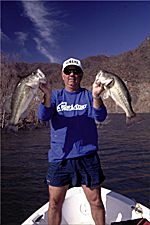
One of the unique features of this lure, and one that makes it highly versatile, is its ability to fall through the water. As I retrieve a Rat-L-Trap, I constantly feel for the lure to hit a structure, like a log or a stump. When this happens, I immediately pause the retrieve for several seconds. This lets the lure fall through toward the bottom. Many of my strikes come as the lure is falling.
Presentation techniques for this lure are as endless as your creativity allows. The rattles inside a Rat-L-Trap make noise with the slightest of movements. This bait can be retrieved slowly for a cold water or early season presentation. It can also be retrieved in rapid, jerking motion to imitate an injured shad effectively.
My favorite method, which has helped me boat several big bass, is Rippin The Trap. As I retrieve and establish the depth I want, I'll "rip" the lure through the water by pulling my rod tip quickly for about 6 to 8 feet. After a "rip," I let the bait fall a few feet and then "rip" it again, right through my desired depth. This puts the quickest action of the lure right through the bass' strike zone several times on each cast. I believe this action causes not only feeding strikes but it provokes agitation strikes as well.
Don't be misled into believing that this crankbait cannot be fished in heavy cover. The design of the Rat-L-Trap actually prevents many hang-ups. Because it's lipless, the contoured front of the lure slides over limbs and logs much more easily than those lures with plastic lips. The favorite hiding place for shad and ambush spot for bass should never be overlooked or underfished. Throw the Rat-L-Trap right in there and be prepared for very satisfying results.
The original Rat-L-Trap, in 1/2 oz. size is a crankbait that's hard to beat. Many manufacturers have copied its effective, lipless design, but nobody has managed to top the performance of the Bill Lewis model.
Every bass angler has his "pet" colors. Bill Lewis Lures has ensured they have a color or combination of colors that appeal to everyone.
With over 100 color variations, the Rat-L-Trap family can be broken down into four basic shades or patterns. The chrome versions are the most popular, and I believe the most productive, of those choices. Chrome/blue back, chrome black back, and all the rest are some of the most deadly bass baits anywhere. Many big bass and big money tournaments have gone to anglers who know the value of chrome "Traps."
The shad patterns are also highly productive. Always remember the baitfish in the particular area you're fishing. Also, remember that there's a Rat-L-Trap to match the color of that prey. Among the shad pattern, the Tennessee shad is always around the top of the list for big bass production.
If perch are the main item on the bass menu, Bill Lewis suggests a chartreuse-colored Trap. Imitating the perch and its slight color variations is another excellent characteristic of the original Rat-L-Trap. Early in the season, shortly after the perch hatch, the 1/4 ounce chartreuse Mini-Trap can be very effective.
Finally, I'll mention the color pattern that's the hottest bass lure in spring tournaments. The crawfish pattern or red Traps have been amazing so far this year. These baits have been good producers, from the electric red to the basic red crawfish. Red is the best color choice for the early spring season, with chrome moving ahead as the water temperature warms.
The critical thing to understand about lure color is that bass react to Rat-L-Traps quickly. There is no hesitation to study the lines or stripes. Predatory fish are interested only in the overall shade of their prey. They don't take the time nor can reason. They simply react positively to positive stimuli. The original Rat-L-Trap is a totally positive stimulus. That's why it works so well.
With offerings in virtually every size I need, I can "Trap" bass regardless of their current size preference of baitfish. Now anglers can choose from six sizes of Rat-L-Trap; 1/8 ounce, 1/4 ounce, 1/2 ounce, 3/4 ounce, 1 ounce, or the hulk of the line, a 1 1/2 ounce Trap. With this variety of sizes and colors available, it's easy to see why I say Bill Lewis has exactly what you need.
In a year, I make thousands of casts. A large percentage of these casts have a Rat-L-Trap attached. So I lend a considerable measure of my success to Bill Lewis Lures and the original chrome/blue-back Rat-L-Trap. Without those two entities, I'd still be looking for logical ways to catch more and bigger bass.


